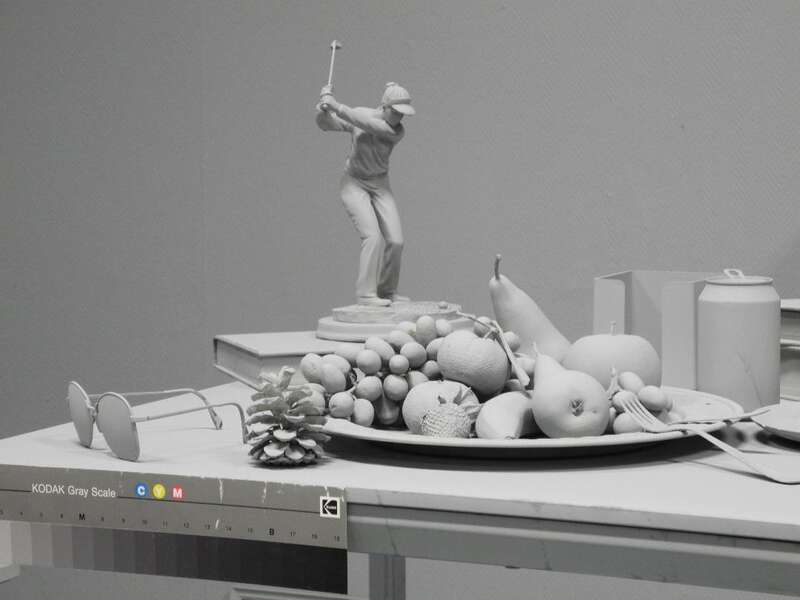
‘That’s My Life Jacket!’
Speculative Documentary as a Counter Strategy to Documentary Taxidermy
The first version of this article was originally published in Critical Arts, 33:1, 60-74 and published online on August 1 2019 (link in bio). It is adapted for Trigger on the occasion of the publication of Trigger nr.2: Uncertainty.
Thomas Bellinck & An van. Dienderen
30 nov. 2020 • 20 min
Introduction: Documentary Taxidermy
In winter 2017, Chinese artist Ai Weiwei premiered his documentary Human FlowHuman Flow, directed by Ai Weiwei Film (2017; United States: AC Films and Participant Media). at the Venice International Film Festival. In sweeping terms, the film’s synopsis states: ‘Artist, activist and director Ai Weiwei captures the global refugee crisis – the greatest human displacement since World War II – in this breathtakingly epic film journey.’Magnolia Pictures, ‘Human Flow: Final Press Notes’, 2017. http://www.magpictures.com/res... It received rave reviews: ‘Ai Weiwei’s refugee documentary weighs on your heart like a cannonball’, The Telegraph said; ‘This is angry, thoughtful, straightforward activist journalism: blunt, simple and impossible to ignore’, Time Out proclaimed; and The Boston Globe said, ‘Ai doesn’t castigate or preach. He doesn’t have to. The facts, the images, speak for themselves. Instead, he bears witness.’ The film was screened at numerous festivals, received several prizes and was shortlisted for an Oscar. At nearly 2.5 hours long, it sees Ai visit more than twenty countries, including conflict zones such as Iraq, Syria and Afghanistan, border zones like that between the United States with Mexico and numerous camps and detention centres in Turkey, Greece, Lebanon, Kenya, Germany and France. More than two hundred crew members and twenty-five cameras were needed to make this high-production film, which was praised for its engaging combination of cinematic quality, social criticism and powerful activism.
But is this really the case? As documentary artists, we (filmmaker An van Dienderen and theatre maker Thomas Bellinck) argue that Human Flow doesn’t address the power differentials between its maker and its subjects, despite its use of formal tropes reassuring the audience that it’s a critical and activist documentary. The film actually traffics in the problematic and dominant imagery of illegalised travellers as helpless victims. Confirming the status quo, it stuns both its subjects and its viewers while taking from both any possible breadth of change. As such, it turns its subjects into taxidermic objects.
In her description of the romantic conservatism in Robert J. Flaherty’s 1922 film Nanook of the NorthNanook of the North, directed by Robert Flaherty (1922; New York). , media scholar Fatimah Tobing Rony coined the term ‘taxidermy’ in this context: ‘The metaphor of taxidermy – a form of representation which is infused with an acknowledgement of death, but also a desire “to be whole” – describes a plethora of technologies popular at the turn of the century used to represent the human body, including photography, film, and wax figures.’Fatimah Rony, The Third Eye: Race, Cinema, and Ethnographic Spectacle (Durham and London: Duke University Press, 1996), 244 Documentary filmmakers are notorious for such dissecting methods. As early as 1887, the Lumière brothers completed the Village Ashanti series, which featured 12 short dances performed by women of colour. Yet, the fact that the series was filmed at the Lyon World Exhibition suggests an entirely different story, one wrapped up in colonialism, imperialism and exploitation. Such documentaries are the result of a delicately obscured ‘taxidermic operation.’ The ‘objects’ of interest – human beings – are carved up and presented as stereotyped distortions, and there’s no room to weigh in on how they’re represented. Moreover, ‘viewers’, missing crucial information about its production process, have no point of reference for assessing the programme’s relation to reality. Unaware of the taxidermist at work, they judge the film’s objectified ‘others’ as precisely that. In this way, taxidermic documentary images, representing clichés, stereotypes and established values that are part of a cultural hegemony, help maintain a certain balance of power.
What’s at Stake When Watching Ai’s Human Flow?
The life jacketisation of illegalised mobility
Like so many other contemporary documentaries – from award-winning films, such as Gianfranco Rosi’s FuocoammareFuocoammare, directed by Gianfranco Rosi (2016; Italy: Stemal Entertainment). and Gabrielle Brady’s Island of the Hungry Ghosts,Gabrielle Brady, Island of the Hungry Ghosts, directed by Gabrielle Brady (2018; Australia: Third Films). to some of our own work – Human Flow is part of a flourishing visual economy grafted onto the illegalisation of certain forms of human mobility. As artists, we unavoidably play a role in, capitalise on and bear responsibility for this visual economy. Its most iconic and lucrative topos is undoubtedly the Mediterranean Sea. On a daily basis, European citizens consume night shots of wet people helplessly reaching for their white saviours, top shots of rickety, overloaded dinghies and side views of dead children washed ashore. As anthropologist Ruben Andersson wrote:
The images...depicting a ‘sea of humanity’ without a past…fix the notion of the clandestine migrant as a helpless, nameless body, sinking into the dark waters. In rescuing this drowning body a virtuous circle is born, where the tasks of patrolling, caring for, and informing on clan- destine migration blur into one another. The production, distribution and appropriation of images – in short, the visual economy of clandestine migration – mirrors and even facilitates this mixing of roles ...Ruben Andersson, Illegality, Inc.: Clandestine Migration and the Business of Bordering Europe (Oakland, CA: University of California Press, 2014), 193–194.
Over the past few years, Ai has created an expanding body of work on the so-called refugee crisis, re-enacting iconic media pictures and fashioning sculptures out of objets trouvés: a contested re-enactment of a picture of the dead body of Aylan Kurdi, the Syrian toddler who washed up on a beach near the Turkish town of Bodrum in 2015; floating lotus flowers made of life jackets scouted on the beaches of Lesbos; a 60-metre inflatable raft made of the same manufactured rubber as the vessels that carry people across the Mediterranean. Rather than appropriating these objects and destabilising the relationship between signifier and signified, Ai literally inserts pieces of reality into these artworks, granting them an aura of authenticity and buttressing his status of artivist. During the shooting of The Miracle of Almería,The Miracle of Almería, directed by Moon Blaisse (2021; Belgium: Cassette for Timescapes). a three-part TV series about the intertwining of industrial agriculture and international labour mobility in the Spanish province of Almería, filmmakers Moon Blaisse and Bellinck discussed a series of artivist artworks with two of the actors. Both actors had migrated from Mali to Almería. The images included a picture of Ai’s covering of the columns of a Berlin concert hall with 14,000 life jackets. Suddenly, one of the actors half-jokingly cried out: ‘Mais ça c’est mon gilet de sauvetage! Qu’est-ce qu’il foute avec mon gilet? Il faut qu’on lui demande de retourner mon gilet! [But that’s my life jacket! What on Earth is he doing with my life jacket? We need to ask him to return my life jacket!].’
Unsurprisingly, Human Flow also opens and closes with images of the Mediterranean, beginning with a sequence of well-composed, meditative shots of unfathomably blue water and dinghies passing by. Then it cuts to an image of Ai crouching in the verge, filming. Then to a chaotic, handheld shot of a rescue mission. Then to Ai sporting the archetypical aid worker’s yellow Day-Glo vest as he supports an exhausted, trembling young man wrapped in an equally archetypical golden emergency blanket. In one of the very first lines of the movie, we hear the man thanking Ai, who touches his cheek and replies: ‘You are a good man.’ The reproduction and circulation of aquatic emergency and rescue images, which we once heard sociologist Emmanuelle Hellio describe as ‘the life-jacketisation of migration’, goes hand in hand with a whole series of water metaphors that have lodged themselves in common parlance. As such, the title of Ai’s documentary – Human Flow – perfectly connects with the U.S. embassy’s leaked cables detailing the ‘waves of migration’ arriving in Greece,The Guardian, ‘US Embassy Cables: Greece Tackles Migration and Asylum Issues’, The Guardian (United Kingdom), 11 January 2011. https://www.theguardian.com/wo... 238229. with the European Commission’s desire to ‘channel’ and ‘stem’ ‘irregular flows’European Commission, ‘Irregular Migration via the Central Mediterranean: From Emergency Responses to Systemic Solutions’, European Political Strategy Centre, 2017 February 2. https://ec.europa.eu/epsc/publications/strategic-notes/irregular-migration-central-mediterranean_en and the BBC’s ‘stream’ of people ‘flooding’ trains in Italy.Bethany Bell, ‘Migrants Flood Trains in Desperate Bid to Leave Italy’, BBC News
(United Kingdom), 20 June 2018. https://www.bbc.com/news/world-europe-33204681 As sociologist Marc Bernardot pointed out, these aquatic metaphors dehumanise people by portraying individuals as an ever-moving and undifferentiated mass, an elementary force of nature in need of hydraulic control.Marc Bernardot, ‘Petit traité de navigation dans la métaphore migratoire.” Multitudes, no. 64 (2016): 63–70.
We don’t want to diminish the tremendous suffering of those who make the passage overseas in any way, but we can’t help but wonder who stands to benefit from the overexploitation of such sea emergency imagery, especially when we consider that illegalised travellers arriving in Italy between March 2016 and January 2017 said they saw more than double the amount of deaths in Libya and the Sahara DesertTara Brian, T. 2017. ‘The Middle East and North Africa’, in Fatal Journeys Volume 3 Part 1: Improving Data on Missing Migrants, ed. by Julia Black, Frank Laczko and Ann Singleton (Switzerland: International Organization for Migration, 2017), 1–20. or that the majority of people illegalized in Europe have never been on a dinghy but are actually visa overstayers.Ruben Andersson,Illegality, Inc. Clandestine Migration and the Business of Bordering Europe, 2014. To what extent does the life-jacketisation of illegalised mobility, which portrays people as passive objects of humanitarian care, underpin the humanitarian rationale and rhetoric of the European Union’s im/mobility regime, which is tasked with that ‘hydraulic control’? It’s certainly worth taking a closer look at the online communications of Frontex, the European Border and Coast Guard Agency. Despite its role in mass surveillance, border enforcement and return operations, Frontex’ visual communication readily makes use of aquatic emergency stereotypes, making their Flickr account at times virtually indistinguishable from that of a search and rescue NGO or a Pulitzer-winning humanitarian photojournalist.
Activism as a visual trope
From the opening aquatic rescue scene onwards, Ai assumes a plethora of roles. He plays the aid worker dragging shipwrecked people ashore. He plays the volunteer grilling sausages on a makeshift barbecue in a camp. He plays the therapist running for a basket into which a woman can vomit while he caresses her hair, telling her ‘It’s OK.’ He plays the empathetic foreign correspondent interviewing numerous specialists from United Nations High Commissioner for Refugees and readjusting the lapel microphone on their clothing. He plays the world-renowned artist talking to a group of young Palestinian women, one of whom is holding a $60 art publication entitled Andy Warhol & Ai Weiwei. But above all, he plays the activist getting his head shaved in a camp. His haircut seems to symbolise his engagement, his activism, his companionship. By shaving his head, he puts himself on par with the camp’s inhabitants, with whom he’s often said to identify because of his own history of dissidence, imprisonment and exile. As he states in the film’s press notes: ‘I see those people coming down to the boats as my family. They could be my children, could be my parents, could be my brothers. I don’t see myself as any different from them.’ Throughout the film, Ai constantly aligns himself with the illegalised people he puts on the screen by visually positioning himself next to them. He participates in their agony by being filmed himself while he’s filming them with his smartphone, just like young people filming a concert in order to participate in the event. He’s filmed while holding a piece of paper that reads ‘#Ai Weiwei stands with refugees’. The audience needs to be convinced that Ai is committed, that he really cares for people in exile, that he shares their anxiety and misery and that his film will make a difference.
This mechanism of identification is carried to an extreme during a scene in which he trades his passport for that of the Syrian Abdullah Mahmoud. After trading some jokes about swapping nationalities, Mahmoud says, ‘If you want to take my tent... ‘ Ai replies, ‘Then you have to take my studio in Berlin. I have a studio in Berlin.’ Then the symbolic reversal of positions is over. We see them swapping their passports again as Ai adds, ‘I respect the passport, and I respect you.’ Quite unintentionally, the scene lays bare one of the most painful discrepancies of the film: the power differentials that exist between Ai and the people whose humanity he wants to portray. While Ai and his film crew travelled to more than twenty countries, the film’s subjects are stuck in front of fences, in camps and in battered tents. With good intentions, he appropriates their misery, but there’s no critical reflection on the different position he holds as an internationally celebrated artist with seemingly unlimited access to funding for his high-production film. As cultural critic T.J. Demos wrote,
the filmmaker’s position functions as a blind spot that remains largely unexamined, [as] Ai’s appearances throughout the film evidence another kind of human flow that receives no comment: that of the privileged tourist or artistic nomad, a figure who has the means to travel with relative ease, owing to elevated economic and cultural status and the right kind of passport. In other words, the film’s condition of possibility owes to the very expanding inequality – as between tourist and asylum seeker – that is symptomatic of the causes of migration in the first place.
Nowhere does Ai address this notion of privilege and inequality. Yet, it’s the maintaining of these privileges and inequalities that lies at the core of Western mobility management. It’s precisely this privilege that connects Ai to the policymakers he interviews, to Human Flow’s opening-night audience at the Venice International Film Festival and to us.
The question of agency
Ai’s activistic hyper-agency starkly contrasts with the lack of agency experienced by both his objectified subjects and his viewers. Human Flow creates a worldview that confirms the existent image production of dominant media in which people whose mobility is illegalised are nameless and powerless victims who follow the rules and demands of static geopolitical forces that remain largely unidentified. Although the film seemingly makes use of its genre’s authoritarian strategies, including voices of authority, facts and figures and headlines from respected newspapers, there’s no insight into the real causes of the humanitarian crisis it portrays. Such documentaries do not challenge the existing paradigm but perpetuate a common-sense framing of reality. Likewise, other than a superficial complaint about global warming, Human Flow offers no real lead into the specific conditions and structural geopolitical powers that have led to this so-called 'refugee crisis', the gargantuan scale of which is constantly stressed. There is a crisis. It’s a static given without any possibility of change.
This numbing stasis most notably infects the way people’s onscreen identities are constructed and communicated. Whereas the classic and expository voices of authority – experts such as doctors, aid workers, policymakers and even an astronaut and Jordanian princess – are always credited by given name, surname and job description, the film’s illegalised travellers have no names or job descriptions. Only in the final credits do their names appear, all together, as one faceless mass of interviewees. Thus, they remain anonymous, homogenised victims of unclear geopolitical forces. Whenever they speak, they’re granted only a couple of brief sentences. At times, their words aren’t even translated but merely subtitled with ‘speaking in Arabic’. Whenever the experts address the illegalised travellers’ conditions, they use the words ‘them’ and ‘they’, never specific names and never implying any agency. The result is that the people in the film can only be thought of as executors of a static worldview.
This lack of subject agency coincides with an induced lack of viewer agency; the latter can’t but consume the static worldview on display. Of course, the overwhelming vastness of the suffering at hand – the causes of which are outsourced to geopolitical power games and incomprehensible evil – makes us feel sympathy but not agency. It invokes a self-deceptive kind of pity that distracts us from our own role in the structural violence that the visual economy of international im/mobility professes to denounce. Essayist Susan Sontag most eloquently described this myopia: ‘So far as we feel sympathy, we feel we are not accomplices to what caused the suffering. Our sympathy proclaims our innocence as well as our impotence.’Susan Sontag, Regarding the Pain of Others (New York: Picador, 2003), 102.
Recalibrating the distribution of the sensible
Human Flow is part of a mass market of liberal humanitarian documentaries consumed on different platforms. According to filmmaker, writer and visual artist Hito Steyerl, these mainstream documentaries often criticise unfair power structures on the content level but fail to do so with regard to form and power differentials. As such, they underscore a large-scale epistemological enterprise that is closely linked to the projects of global capitalism and Western colonialism.Hito Steyerl, ‘Documentary Uncertainty’, in Re-visiones, no. 1 (2011). http://www.re-visiones.net/spip.php% 3Farticle37.html. But, as Demos stressed, rather than simply dismiss Human Flow as merely the most recent in a long line of liberal humanitarian portrayals that, in playing to its viewers’ emotions and empathy, do little to address the massive challenges of the situation, we should ask how we can work toward progress otherwise.Demos, ‘Migrant World’.
In our own respective practices, we want to (and must) ask how we can critically question the power structures inherent in documentary making. How can we, in our own work, steer clear of market-driven, taxidermic formatting? How do we deal with our own inevitable blind spots and positions of power? How do we remain aware of how we’re incessantly mobilised as the agents of the very violence we aspire to denounce? How can we, as artist and theorist Ariella Aïsha Azoulay called it, ‘unlearn the imperialism’Ariella Azoulay, Potential History: Unlearning Imperialism (London, Brooklyn: Verso Books, 2019). inherent to documentarism as part of a historical apparatus of control that equally includes taxidermy, anthropology, biology, archaeology, museum and archival practices? How can we undermine the documentary’s ensuing authoritative claim to knowledge and truth? How can we share authorship and embrace multiple forms of embodied, often unacknowledged expertise? How can we recalibrate what philosopher Jacques Rancière called ‘the distribution of the sensible’Jacques Rancière, Le partage du sensible: Esthétique et politique (Paris, France: La Fabrique Éditions, 2000). the implicit set of rules that determines what can or can’t be perceived, seen, heard, said, thought, made or done? Interestingly, Rancière stressed the importance of ‘dissensus’ over ‘resistance’:
I would rather talk about dissensus than resistance. Dissensus is a modification of the coordinates of the sensible, a spectacle or a tonality that replaces another...That’s one way of keeping one’s distance from the shopworn affect of indignation and instead exploring the political resources of a more discrete affect – curiosity.Fluvia Carnevale and John Kelsey, ‘Art of the Possible: In Conversation with Jacques Rancière’, Artforum 45, no. 7 (2007): 256–269.
Hoping to strengthen the continuous search for dissensus in our own work, we wonder if we can draw inspiration from that of the historical vanguards of documentary film, photography and theatre. Even though documentary has traditionally been associated with certainty, truth and objectivity, it’s been equally anchored in uncertainty, dispute and contamination ever since its inception.Erika Balsom and Hila Peleg, eds, Documentary Across Disciplines (Cambridge, MA: Haus der Kulturen der Welt and the MIT Press, 2016).
Documentary’s Disparate Origins
Reviewing Flaherty’s third film Moana in 1926, filmmaker and critic John Grierson was one of the first to label the emerging taxidermic genre as ‘documentary’, defining it as ‘a creative treatment of actuality’.John Grierson, ‘Flaherty’s Poetic Moana’, New York Sun (New York), 8 February 1926. Significantly, Grierson borrowed the term from the French denomination for the exoticising colonial travelogue films of the time.Timothy Youker, Documentary Vanguards in Modern Theatre (New York: Routledge, 2018). So from the outset, the genre was fraught with questions of ideology and representation and buttressed by its reliance on infrastructurally violent technologies that were – and still are – commonly perceived to be neutral. Consider, for instance, the built-in white-centring tendencies of photographic media, which use Caucasian skin as their standard reference for calibration so that people who don’t conform to this implicit norm are erased or filmed in a distorted way.Brian Winston, Technologies of Seeing: Photography, Cinematography, and Television (London: British Film Institute, 1996); Ella Shohat and Robert Stam, eds., Multiculturalism, Postcoloniality, and Transnational Media. (New Brunswick, New Jersey and London: Rutgers University Press, 2003); An van. Dienderen, ‘On “Lili”. Questioning China Girls Through Practice-Based Research’, Critical Arts, Journal on South-North Cultural and Media Studies 31, no. 2 (2017): 72–86.
However, documentary’s birth as an instrument of Western imperialism, which was grafted on what Azoulay described as the ‘institutionalization of neutrality’,Azoulay, Potential History, 42. ran parallel to documentarist experiments of a wholly different nature. Around roughly the same time as Grierson published his review of Moana, theatre practitioner Bertolt Brecht wrote an article cheering the radical experiments in ‘political theatre’ by director-producer Erwin Piscator, hailing ‘the creation of a great epic and documentary theatre, which will be suited to our period’.Anthony Squiers, An Introduction to the Social and Political Philosophy of Bertolt Brecht: Revolution and Aesthetics (Amsterdam and New York: Editions Rodopi, 2014), 59. In the theatre, the documentary was heralded as an avant-gardist art form challenging bourgeois capitalist dramatic conventions. Heavily influenced by Dada and soviet agitprop, it was marked by experiments in mixed media, collective creation, photomontage and collage.
Despite the many differences in form, context and contents, we’ll attempt to describe a few salient features of the work of early documentary makers like Bertolt Brecht (1898–1956), Maya Deren (1917–1961), Jean Epstein (1897–1953) and Erwin Piscator (1893–1966). While Flaherty was spearheading the taxidermic format, they were exercising other forms of reality negotiation through the creation and reappropriation of documents, transgressing the borders between fact and fiction, different artistic discipline and art and activism. We believe that a closer look at their endeavours and failures may inspire an altogether different reading of the documentary gesture’s disparate origins and its critical and transformative potential.
Showing Has to be Shown
Today, the idea still persists that images represent reality without any censorship or manipulation whatsoever. This proclivity can be termed ‘image positivism’, i.e., the positivist or naturalistic belief that what’s being represented accurately depicts what was experienced. Even within our own artistic projects, we’ve had heated debates with colleagues who insist that the camera never lies. As filmmaker and writer Trinh Minh-ha stated,
At the core of such a rationale dwells, untouched, the Cartesian division between subject and object that perpetuates a dualistic inside-versus-outside, mind-against-matter view of the world. Again, the emphasis is laid on the power of film to capture reality ‘out there’ for us ‘in here’. The moment of appropriation and of consumption is either simply ignored or carefully rendered invisible according to rules of good and bad documentary.Trinh Minh-ha, ‘Documentary Is/Not a Name’ October 52, no. 1 (1990): 76–98, 83.
However well or badly hidden, however conscious or not, documentaries always comprise their makers’ positions towards the philosophical question of how they perceive reality and what paradigm of it they relate to. After all, the paradoxical starting point of any documentary gesture is that whenever one observes reality, it mutates or vanishes into thin air. Instead of pretending to ignore this given, it’s more interesting to relate it to the impossibility of accessing reality in an unmediated manner. Brecht was very much aware of this when he called his theatre ‘non-Aristotelean’, rejecting the ancient philosopher’s premise of an unproblematic relationship between reality and our observation and representation of it.Youker, Documentary Vanguards. Highlighting the importance of complex seeing, Brecht wished to dismantle hegemonic forms of representation and stimulate the audience into critically analysing what was presented as reality through techniques of estrangement, the purging of the stage of all illusion, the juxtaposition of different representations of the same facts and the rendering visible of all theatrical machinery and artifice. According to Brecht, this requires a completely different style of acting: ‘the actors must invest what they have to show with a definite gestus of showing.’Bertolt Brecht, Brecht on Theatre, edited by Steve Giles, Tom Kuhn and Marc Silberman (London, New Delhi, New York and Sidney: Bloomsbury, 2000), 439. Or, as goes the title of a famous poem by Brecht, ‘Showing Has to be Shown’.
Documentary as a tool for social transformation
Likewise, in contrast with the aforementioned positivist rationale and the Cartesian dualism that Trinh highlighted are the writings of Epstein, a theorist and filmmaker. From the 1920s onwards, he ceaselessly stressed the need to cultivate what he called cinema’s ‘photogénie’, the medium’s inclination towards the indeterminate and the permanently moving and changing, contradicting all knowledge systems based on the establishment of stable rules.Erika Balsom, ‘One Hundred Years of Low Definition’, in Indefinite Visions: Cinema and the Attractions of Uncertainty, edited by Martine Beugnet, Allan Cameron, and Arild Fetveit (Edinburgh: Edinburgh University Press, 2017), 10, 73–89. Brecht shared his insistence on movement and the perpetual possibility of change, emphasising that human nature isn’t fixed and humankind is changeable and able to change: ‘Briefly, the Aristotelian play is essentially static; its task is to show the world as it is. The learning-play is essentially dynamic; its task is to show the world as it changes (and also how it may be changed).’Brecht, Brecht, 297–298. To him, this was the sine qua non of contemporary representation: ‘the present-day world can only be described to present-day people if it is described as changeable.’Brecht, Brecht, 727. Such was the aim of his epic style, to ‘arrive at a point where spectators no longer see the persons on stage as unchangeable, closed off to influence, helplessly resigned to their fate.’Brecht, Brecht, 347. In Brecht and Piscator’s mobilisations of theatre as a tool for social transformation, Grierson’s definition of documentary as a ‘creative treatment of actuality’ took on an almost surgical meaning. ‘Piscator saw the theatre as a parliament, the audience as a legislative body.’Brecht, Brecht, 330. The epic theatre of Piscator and Brecht hoped to centre the questions of spectatorship, participation and handing over control of part of the production process, even to the point of aspiring to ‘remove the spectators and tolerate only practitioners.’Brecht, Brecht, 286.
However, it’s debatable whether Piscator ultimately managed to reach the proletarian audience that he longed to involve in his parliament-theatre. Actress and director Judith Malina, who trained with Piscator, strikingly assessed the disconnect between his aspirations and their realisations:
My teacher, Erwin Piscator, used to imagine that. But he didn’t like it even if someone coughed during the performance. Ha! You know, he had one idea and another activity, and his practice didn’t quite live up to his ideal. Erwin Piscator believed in audience participation, but he had no idea what it really could be, because he was a little afraid of the audience.Annie Dorsen and Judith Malina, ‘Poetry is No Poverty, and No Poverty is Poetry’, in Not Just A Mirror: Looking for the Political Theatre Today, edited by Florian Malzacher (Berlin: Alexander Verlag, 2016), 80.
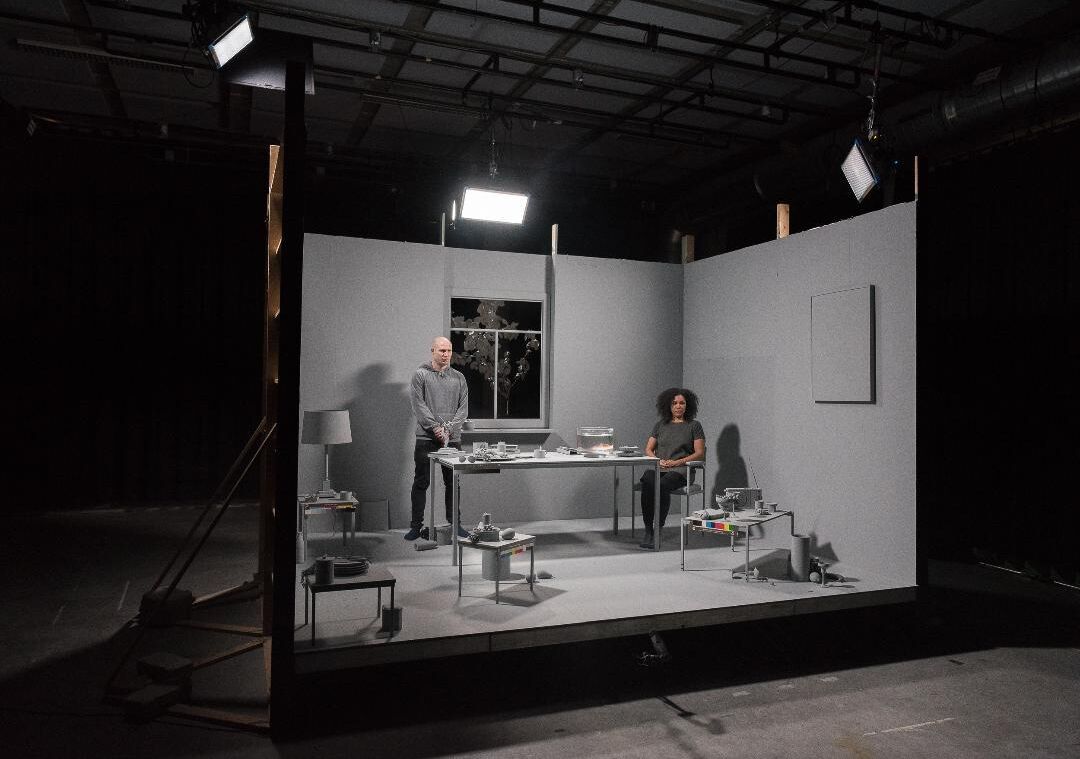
Still from Prism, An van. Dienderen, 2020 ©Thomas Nolf
The documentarist as a magician
Though not from a cultural materialist position, the belief in transformative potentiality also formed the root of poet, photographer, ethnographer, dancer and filmmaker Maya Deren’s sense of cinema. For her, cinema was a medium based on the combination of discovery and invention. She saw the filmmaker as a magician who, through the filmed concrete details of conventional reality, illuminated the uninitiated and convinced them of the existence of an alternative universe. The reality performed in her films perhaps didn’t exist in real life (yet), but the filmmaker could be bring it to life.Lucy Fischer, ‘The Eye for Magic’, in Maya Deren and the American Avant-Garde, edited by Bill Nichols (Berkeley, Los Angeles and London: University of California Press, 2001), 185–204. For Deren, this process of creation consisted of making the invisible visible.Moira Sullivan, ‘Maya Deren’s Ethnographic Representation of Ritual and Myth in Haiti’, in Maya Deren and the American Avantgarde, edited by Bill Nichols (Berkeley: University of California Press, 201), 208.
Inspired by Voudon during her multiple visits to Haiti, Deren called her films ‘rituals involving minimalization of personal identity.’Maya Deren, ‘Film in Progress, Thematic Statement’, Film Culture, no. 39 (1965): 11. Her attraction to Voudon possession ceremonies stemmed from a need to decentre thoughts of self, ego and personality.Bill Nichols, Maya Deren and the American Avant-Garde, (Berkeley, Los Angeles and London: University of California Press, 2001), 268. In her work, she tried to understand hysteria, trance and ritual as social acts of collective association rather than personal dysfunctions. As a dancer, cinematographer and filmmaker, she was interested in embodied knowledge, in the experience of the movement during ceremonies she participated in. Her purpose was not to record rituals but – through her participation as a dancing camerawoman – to provide a system of documentation that integrated mythical symbols through the mobile body.Sullivan, ‘Maya Deren’s’, 217. Deren ended up shooting twenty thousand feet of 16 mm film during Haitian Voudon ceremonies, but she never finished the editing. Interestingly, her failure to edit the material points to a problem that documentary filmmakers still struggle with: how do we deal with power relations when participating in rituals? How can we partake in embodied community experiences while at the same time authoring a document that represents them? How can we express depersonalised, community-based dynamics while at the same time single-handedly forging the end result?
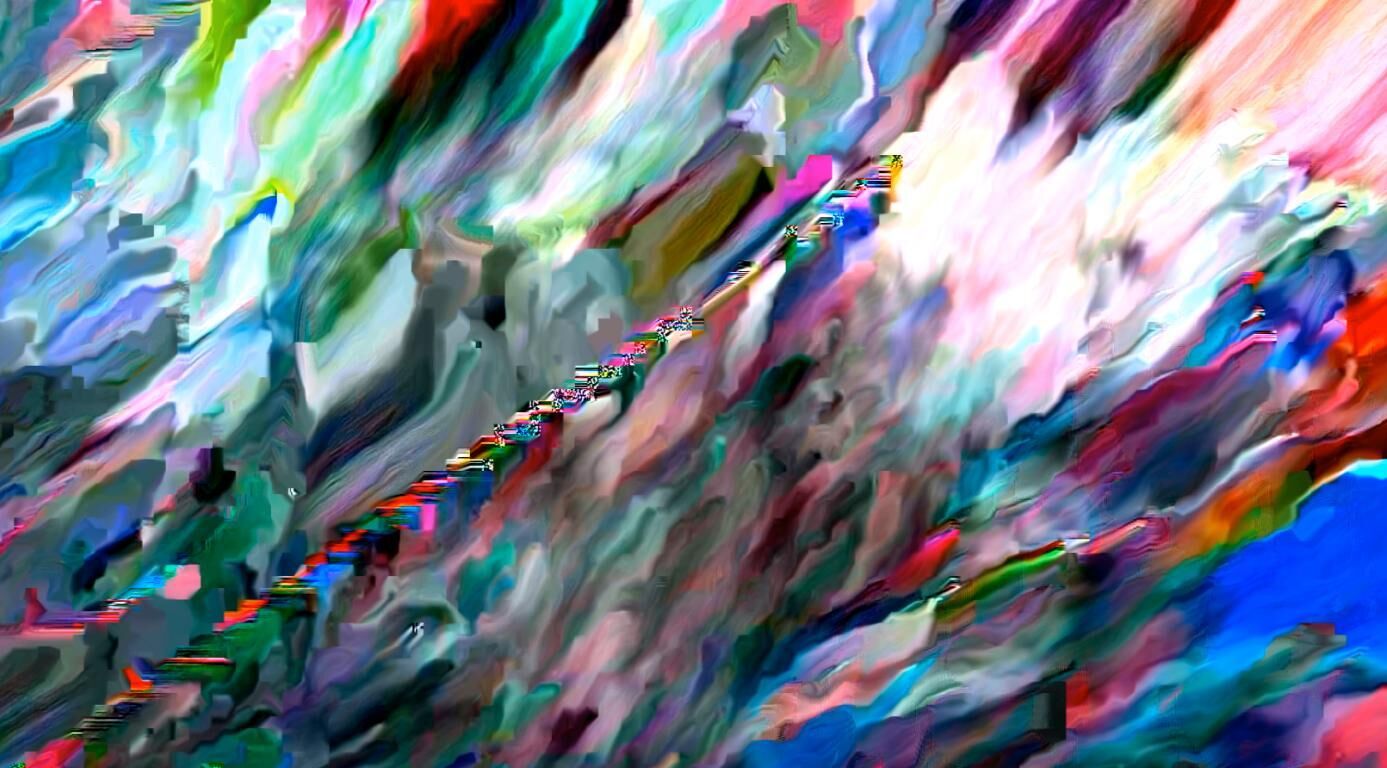
Still from Letter from Home, An van. Dienderen, 2015 ©Elias Heuninck
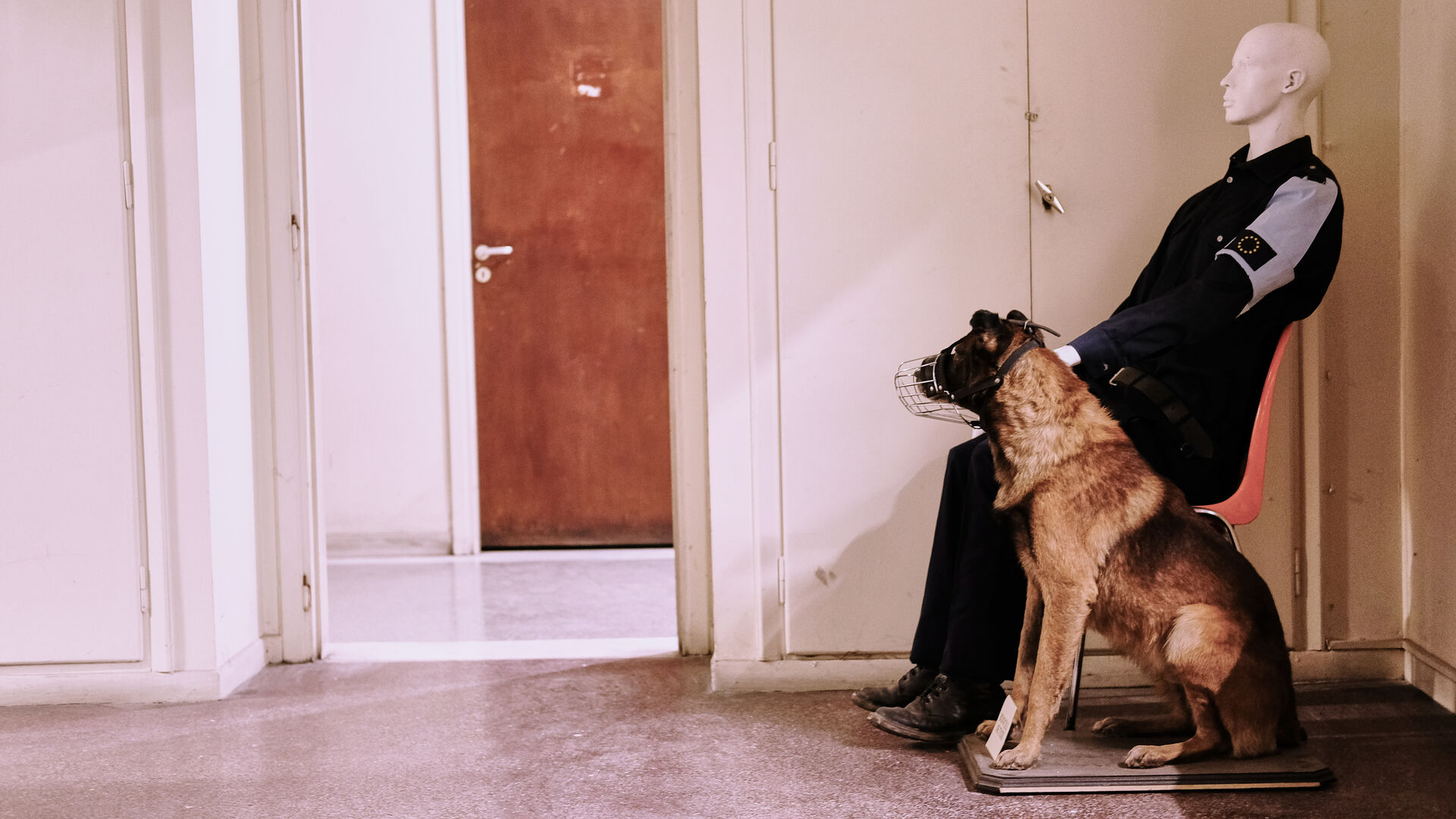
Domo de Eŭropa Historio en Ekzilo, Thomas Bellinck, 2016 ©Christos Sarris
Speculative Documentary
Despite its many differences, internal contradictions and failures, a rereading of the work of the above avant-garde artists reveals a whole other possible paradigm of documentary representation. Going against the grain of a taxidermic mainstream and its fetishisation of certainty, truth and objectivity, their work manifests a fervour to challenge dominant formatting, an insistence on the intertwining of ethics and form, an awareness of existing power differentials and of the impossibility of accessing the real in an unmediated manner as well as a belief in the transformative potential of art. In 2018, inspired by these attributes and propelled by the urge to put forward a different contemporary model of documentary, we founded The School of Speculative Documentary, together with photographers Michiel Decleene and Max Pinckers. Below, we will expound on the speculative model advocated by the school and touch upon some strategies we explore in our own respective practices.
Uncertainty and messiness
The speculative documentary gesture that we exercise is based on conjecture rather than knowledge. As Hito Steyerl wrote, uncertainty underlies the contemporary documentary genre:
The perpetual doubt, the nagging insecurity – whether what we see is ‘true’, ‘real’, ‘factual’ and so on – accompanies contemporary documentary reception like a shadow. Let me suggest that this uncertainty is not some shameful lack, which has to be hidden, but instead constitutes the core quality of contemporary documentary modes as such....The only thing we can say for sure about the documentary mode in our times is that we always already doubt if it is true.Steyerl, ‘Documentary’.
We openly embrace the perpetual uncertainty Steyerl pinpointed as well as the fogginess, clumsiness and messiness typical of the relations that, over the course of centuries, have developed between representation and reality, between the West and its constructed others. This jumble of links, associations and paradoxes in which artists incorporate their uncertainty about these relations contrasts sharply with the illusion of the dichotomous relation between the us and them that Flaherty and many other taxidermic documentarians have presented. Clearly, this type of messiness doesn’t want to create confusion for the sake of aesthetics. It’s a productive strategy simultaneously entangled in the complexity of relationships between the West and its constructed others and with an aesthetic category defying classic formats in which ideological connotations are assigned to the constructed other.
This idea of messiness is taken to its extreme in An van Dienderen’s film Letter Home,Letter Home, directed by An van Dienderen (2015; Belgium: Elektrischer Schnellseher). in which she exploits it as a formal principle. Filmed in Japan, the film’s idea was to degenerate generic tourist images in order to dwell on the sensoriality of impressions that come with living in a place where you don’t understand the language. For this purpose, van Dienderen processed her original material, recorded with a camcorder, with the use of confusing algorithms. This positioned the materiality and texture of the electronic image in the foreground. The resulting film is literally messy, evoking a chaotic mosaic of colours and impressionistic pixels. We see the world as through a window soaked in water and distorting every move, only for it to suddenly stiffens as if encrusted with frost. In a way, Letter Home’s blurriness is reminiscent of pictorialist photography of the late nineteenth and early twentieth centuries.Balsom, ‘One Hundred Years’, 80. These blurring aesthetics, with their entanglement in ethical and ideological values, go against the belief that images can simply reproduce reality.

Simple as ABC #2: Keep Calm & Validate, Thomas Bellinck, 2017 ©Laura Van Severen
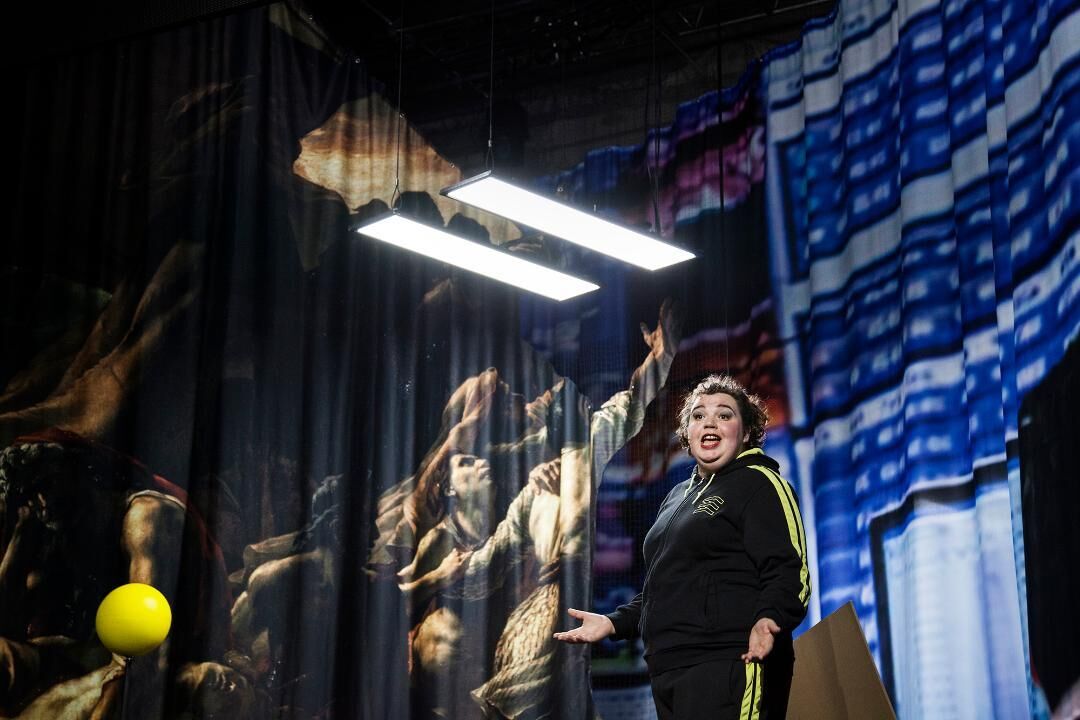
Simple as ABC #2: Keep Calm & Validate, Thomas Bellinck, 2017 ©Laura Van Severen

Still from Lili, 2015 ©An van. Dienderen, Courtesy of the artist
Gaps and blind spots
As speculative documentarians, we’re duly aware that the multiple and mutable realities we create and engage with are marked by gaps. It seems these gaps are inevitable if only because, as philosopher Slavoj Žižek pointed out, we can never look from a distance at an objective reality; rather, we’re always incorporated in the images we create.Levi Bryant, Nick Srnicek and Graham Harman, eds., The Speculative Turn: Continental Materialism and Realism (Australia: re.press, 2011). We ourselves are our own greatest blind spot. Scholar and critic Erika Balsom and curator and filmmaker Hila Peleg stressed that documentary isn’t a neutral picturing of reality but ‘a way of coming to terms with reality by means of working with and through images and narrative.’Balsom and Peleg, Documentary, 13. The speculative documentary revolves around this notion of coming to terms. Indeed, the question isn’t how to cover up the gaps – rather, it’s about acknowledging them and entering into a negotiation with them.
This coming to terms with an unstoppable gap was at the heart of the creation process of Bellinck’s Simple as ABC #2: Keep Calm & Validate,Simple as ABC #2: Keep Calm & Validate, directed by Thomas Bellinck (2017; Belgium: ROBIN). a documentary musical about the digitisation of mobility management. Made in the same year as Human Flow, and about a similar topic, the difference in its paradigm of reality couldn’t be more striking. During an initial research phase in 2016, Bellinck travelled to Lesbos. For months, the island had dominated international headlines as the epicentre of the European reception crisis. But quite contrary to the aquatic emergency imagery in Human Flow, there hadn’t been a single boat in sight for days. Everybody was speculating wildly about the how and why, but nobody could come up with an adequate explanation. The same happened in Eidomeni, a little town on the border of Greece and Macedonia that’s also featured in Human Flow. For months, buses with thousands of people had been coming and going. But upon arriving in Eidomeni, all Bellinck encountered were brand-new, deserted camps and aid workers lounging about smoking. Once again, nobody could come up with an adequate explanation. This triggered a shift away from the stereotypes of the visual economy of international im/mobility, allowing him to scrutinize the borderscape in all its infrastructural nakedness. The happenstance gap was painfully echoed in Bellinck’s interviews with several border managers, working for different European Union institutions and agencies. In the latter’s mental landscape illegalised travellers seemed equally missing – not as homogenised objects to be managed, of course, but as thinking, speaking, acting subjects. Simple as ABC #2: Keep Calm & Validate arose from these gaps, these different forms of nonappearance and disappearance: the glaring absence of those who are managed created an opening to focus on those who manage and how and why they do. Rather than being deflected by myopic sympathy for drowning bodies in need, this left him and the audience to reflect on their own privilege and their own position within and responsibility for the apparatus of Western mobility management.
In a wholly different way, van Dienderen’s film LiliLili, directed by An van Dienderen (2015; Belgium: Elektrischer Schnellseher). also investigates white-centric power dynamics and its inherent privileges. The film turns its attention to the phenomenon of China Girls, images of Caucasian women used in cinema history to calibrate the colours of the camera. The visual format is quite simple: a woman is filmed with colour-grading cards. This image is then edited within the reel leader of the film, addressing the technicians who use these colour-timing strips to create visual continuity between shots and scenes filmed in different lighting conditions or on different film stocks. Except for communications professor Lorna RothLorna Roth, ‘Looking at Shirley, the Ultimate Norm: Colour Balance, Image Technologies, and Cognitive Equity’, Canadian Journal of Communication 34, no. 1 (2009): 111–136. and culture and media scholar Genevieve Yue,Genevieve Yue, ‘Color Imbalance: Film, Race, and the China Girl’, paper presented at Macalester. College’s American Studies Colloquium Series on 8 March 2012 in Minnesota; Genevieve Yue, ‘The China Girl on the Margins of Film’ October 153, no. 2 (2015): 96–116. http://www.l-camera-forum.com/leica-news/2012/11/test-chart-bbc61-lady/ few authors have mentioned the problematic factor that the women — although referred to as Chinese – were almost always White or Caucasian. The Caucasian skin is used as a reference for the grading of camera and printing, ultimately excluding people who don’t conform to this implicit norm. The China Girls practice started in the 1920s but is still in use today, ever-reintroduced in new technologies. With Lili, van Dienderen questions the white-centricity of photographic media, which, as stated by film scholar Richard Dyer,Richard Dyer, ‘The Light of the World’, in White (London and New York: Routledge, 1997), 82–145. already assumes, privileges and constructs whiteness. To that end Lili mixes fictional and documentary codes, constructing a fictional voiceover that blends with archival images and re-enactment. The film offers to set in motion the normative powers of technological development, issuing a critique on chromophobia in Western culture as an invitation to challenge dominant formatting.

Domo de Eŭropa Historio en Ekzilo, Thomas Bellinck, 2018 ©Stef Stessel
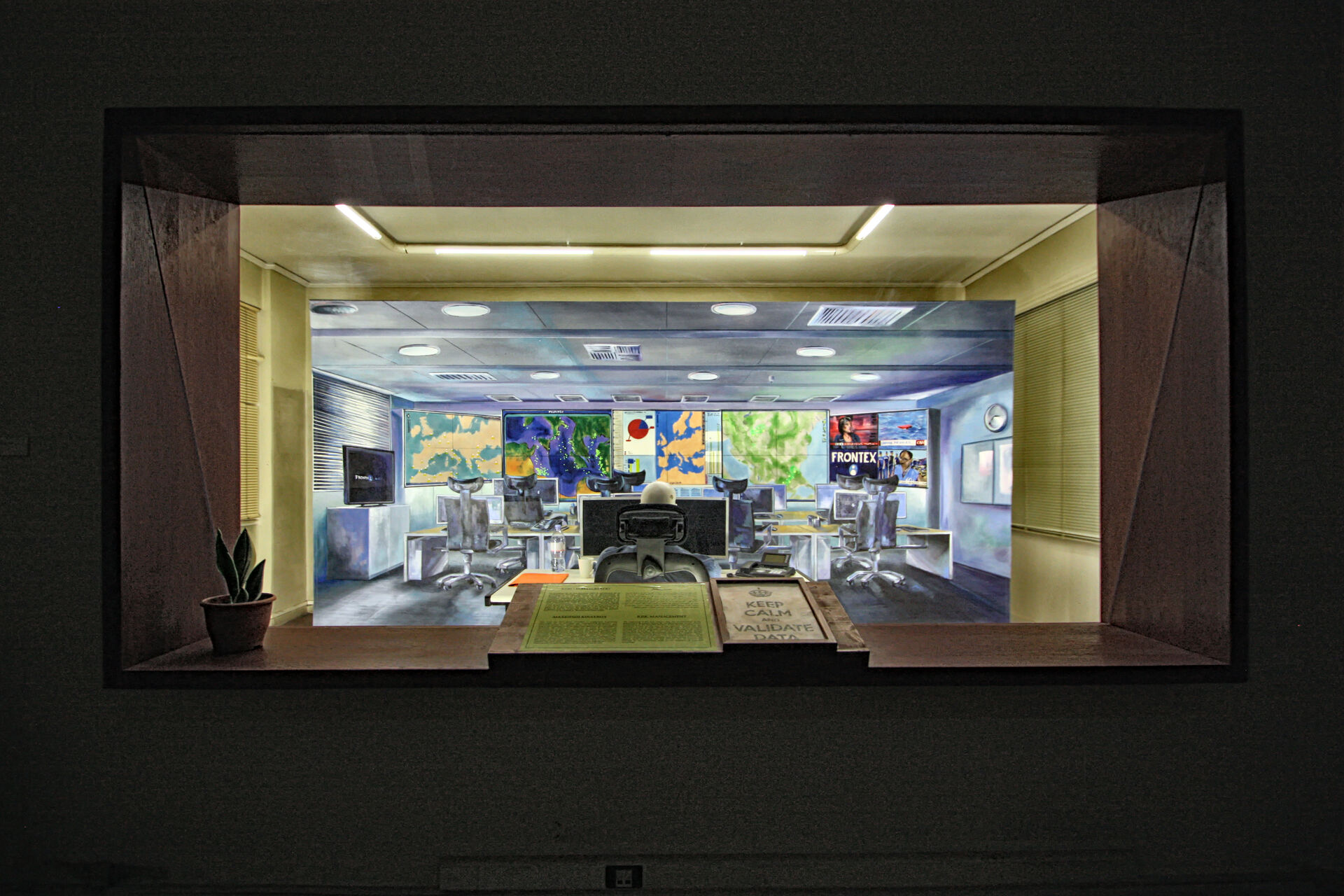
Domo de Eŭropa Historio en Ekzilo, Thomas Bellinck, 2016 ©Thomas Bellinck
Pre-enactment
In our attempts to come to terms with our own blind spots and the unstoppable gaps in reality, speculation often occupies centre stage. We believe in the imaginative power of the utopian potential mood, in what if rather than the mimetic as if: I’m not saying something is true, real or possible, but what if it were? In his practice, Bellinck often works with pre-enactments, reconstructions of an (im)possible future. For instance, in Domo de Eŭropa Historio en Ekzilo,Domo de Eŭropa Historio en Ekzilo, directed by Thomas Bellinck (2013–2018; Belgium: KVS and ROBIN). an immersive installation disguised as a historical museum, Bellinck looks back on the collapse of the European Union between 2008 and 2023 from the point of view of the distant future. To a certain extent, one might also call the closing scene of his Simple as ABC #2: Keep Calm & Validate a pre-enactment. In it, the idea of the gap is literally deployed as a speculative narrative device. The audience is asked to imagine that the entire border management infrastructure disappears one night. This time, those who are managed don’t disappear, but rather the management armamentarium does. Entire floors disappear from glass skyscrapers, surveillance planes dissolve into thin air, all management activity grinds to a fabulous standstill. What remains are thousands of delicate bodies in an empty field, a little dazed by their accidental proximity. Those who used to manage look as unsettled as those who were on the road. Through this surreal disappearance, a new potential space of appearance arises. This space of appearance was defined by philosopher and political theorist Hannah Arendt as a space where people appear to each other as thinking, speaking, acting subjects, a space where, as equals, they can negotiate a world that didn’t exist before.

Simple as ABC#3: The Wild Hunt, Thomas Bellinck, 2019 ©Laura Van Severen
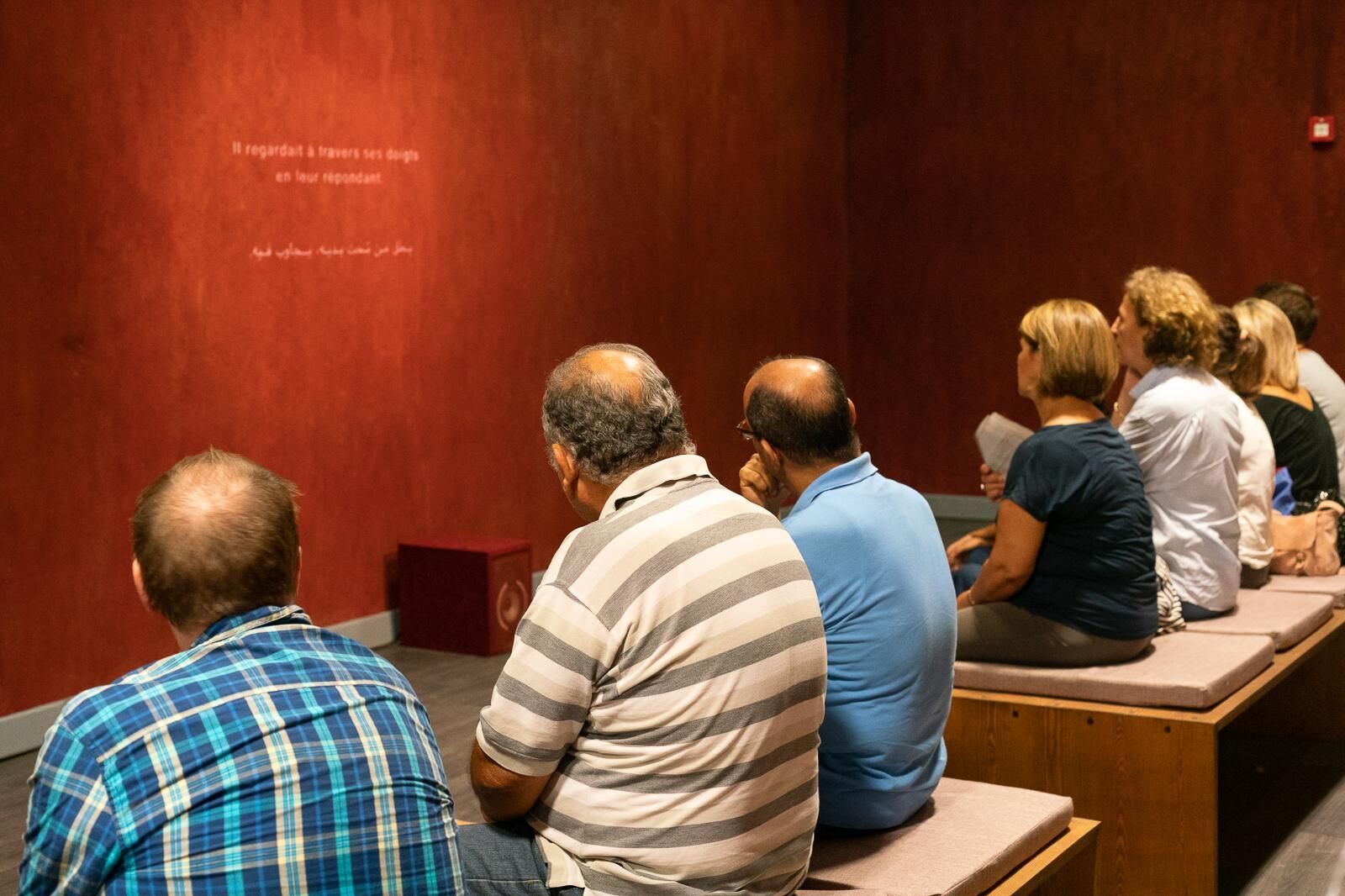
Simple as ABC #4: The Museum of Human Hunting, Thomas Bellinck, 2019 ©Pol Guillard
Co-creation
In the audio performance Simple as ABC #3: The Wild HuntSimple as ABC #3: The Wild Hunt, directed by Thomas Bellinck (2019; Belgium: ROBIN). and the ensuing immersive installation Simple as ABC #4: The Museum of Human Hunting,Simple as ABC #4: The Museum of Human Hunting, directed by Thomas Bellinck, (2019; Belgium: ROBIN). Bellinck tried to dig deeper into this field of tension between visibility and imposed invisibility. However, this time, he embarked on an act of speculation with a team of paid experts who, in the dominant visual economy of international im/mobility, are too often confined to the role of objectified subjects. The premise of both projects was precisely this: to invite and remunerate, as experts, the people who are usually captured in an image and instead ask them what image they themselves would like to compose. From Afghan journalists in exile in Greece and a guard involved in illegal push-back operations on the border between Greece and Turkey to Tunisian citizens involuntarily returned to Tunisia or a people smuggler operating out of Tunis, all experts collaborated on the basis of their intimate knowledge of what it means to construct, capitalise on or be physically and psychologically subjected to the European Union’s external border. The audio performance was triggered by a passage in Greek philosopher Aristotle’s Politics that establishes the concept of ‘natural subjection’ and subsequently legitimises the idea of hunting like ‘wild beasts’ those humans ‘who, though intended by nature to be governed, will not submit.’ Together, Bellinck and the team of experts fantasised about what would happen if they were to build a human hunting museum. What would it look like, who would be in it, what would hang on the walls, who’s hunting whom and how, and how clear cut or reversible are such categories? Connecting Aristotle’s infamous legitimation of human hunting with his famous definition of tragedy, they exchanged views on and experiences with representations of violence as well as the violence of representation. Ultimately, all experts were invited to audiotape human hunting experiences that are etched on their retinas as if they were describing a painting in a museum gallery. The resulting audio exhibition consisted almost solely of scenographed, subtitled sound snippets in multiple languages. As their bodies were held up at or on the other side of some European Union border, through their voices alone, the experts guided the audience through an imaginary collection of ephemeral hunting scenes.

Still from Prism, An van. Dienderen, 2020 ©Thomas Nolf
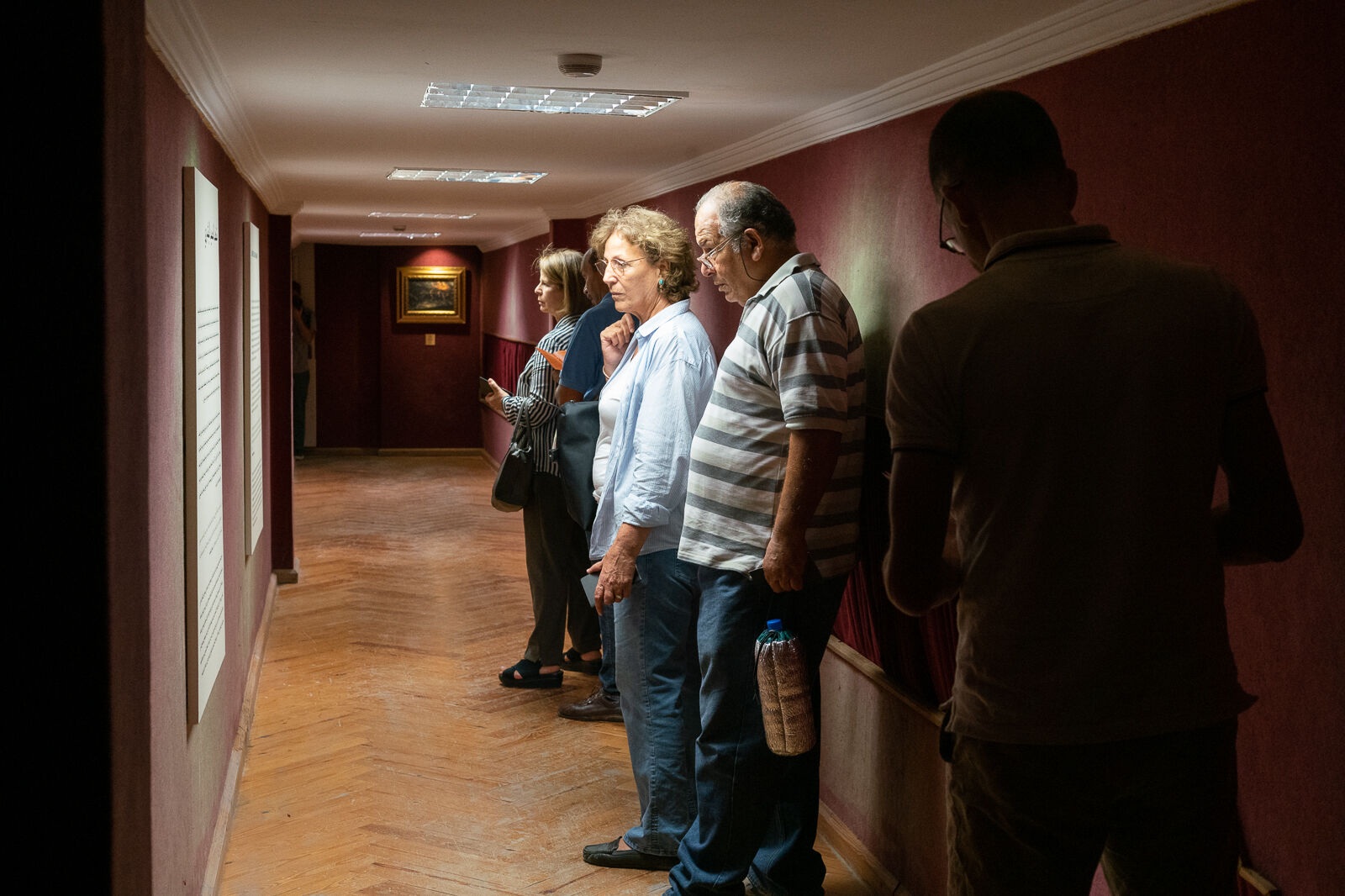
Simple as ABC #4: The Museum of Human Hunting, Thomas Bellinck ©Pol Guillard
This desire to co-create – to share authorship – is also at the basis of van Dienderen’s ongoing film project PRISM, for which she invited Brussels-based Rosine Mbakam from Cameroon and Paris-based Eléonore Yaméogo from Burkina Faso to work with her. The differences in their skin colours served as a point of departure for exploring their different experiences with the aforementioned limitations of a technologically and ideologically biased medium that favours Caucasian skin. Since the conception of cinema, indifference to the representation of different skin colours has been built into the technology, from the models used as standards for adjusting colour and tone to the calibration of film stock emulsions and light metres.Ann Hornaday, ‘Howard University Has Become Incubator for Cinematographers’, The Washington Post (Washington), 28 January 2013. https://www.washingtonpost.com/entertainment/movies/howard-university-has-become-incubator-for-cinematographers/2013/01/28/39202f00-697f-11e2-ada3-d86a4806d5ee_story.html?tid=a_inl&utm_term=.3aa753c1c677 This embedded racism expanded from the technique to the aesthetic of film, ignoring or deforming the black body, for instance, from the very beginning. PRISM starts from the following question: how can we, three makers with different skin colours, be together in one frame? And how can we create a common film about this topic? PRISM explores these questions from a diversity of voices in the form of a chain letter in which one part of one filmmaker inspires a part of another, in which the scenario of one stimulates the scenario of another and in which images move back and forth and sounds are shared. The film thus problematises the objectivity of the camera and its inequality of power to tackle other inequalities in society based on skin colour. While the film deconstructs these issues, it also tries to reconstruct them by creating a film in a collaborative manner, thereby overcoming the biases.
Reclaiming the Documentary Gesture
This article builds on the insights developed in two previous articles on the ethnographic turn in contemporary arts published in the academic journal Critical Arts.Kris Rutten K., An van Dienderen and Ronald Soetaert, ’Revisiting the Ethnographic Turn in Contemporary Art, Critical Arts. South-North Cultural and Media Studies 27, no. 5 (2013): 459–473; Kris Rutten K., An van Dienderen and Ronald Soetaert,‘The Rhetorical Turn in Contemporary Arts and Etnography’, Critical Arts. South-North Cultural and Media Studies 27, no. 6 (2013): 627–640. Questioning art critic and historian Hal Foster’s infamous essay ‘The Artist as Ethnographer?’,Hal Foster, ‘The Artist as Ethnographer?’ in The traffic in Culture: Refiguring Art and Anthropology, edited by George Marcus and Fred Myers, (Berkeley, LA and London: University of California Press, 1995), 302–309. both articles advocated for practice-based artistic research. As compared to traditional research, practice-based research in the arts conveys the impression of being unable to go beyond the single case it describes. Sociologist Patricia Leavy, however, refuted this superficial duality: ‘Although the knowledge claims produced in this kind of research practice are intended to be ambiguous enough to allow for multiple, multidimensional, complex, dynamic, intersubjective and contextual interpretations, this is also their strength.’Patricia Leavy, The Oxford Handbook of Qualitative Research (Oxford and New York: Oxford University Press, 2014), 417. It’s precisely by zooming in on our own practice-based research that we’ve been able to highlight certain speculative documentary strategies. These messy, phantasmagorical, collaborative strategies ‘make us doubt and reconsider the world and its representations not as givens, but as complex, vague and unfixed.’Martine Beugnet, Allan Cameron and Arild Fetveit, eds, Indefinite Visions. Cinema and the Attractions of Uncertainty (Edinburgh: Edinburgh University Press, 2017), 10. Through them, we hope to modify the coordinates of the sensible and reclaim the documentary gesture from the manifold formatted, taxidermic mainstreams, exploring its full capacity to resist, challenge and subvert dominant epistemologies still rooted in colonialism and global capitalism.
Acknowledgements
We wish to thank Souleymane, Sidi, Moon Blaisse, Michiel De Cleene, Emmanuelle Hellio, Max Pinckers, Esther Severi, Emile Van Binnebeke and Paul Carlucci for their generous and inspirational input. This article is part of the research project Simple as ABC: In Search of Speculative Documentary Gestures to Profanate Regimes of Im/Mobility, which was initiated by Thomas Bellinck in 2016 and will run until 2022. It’s also part of the research project China Girls and the Color Genie. A Multichronotopic Research, which ran from 2015 to 2019, and the following research project from 2020 onwards initiated by Dr An van Dienderen. Both research projects are affiliated with KASK & Conservatorium, School of Arts Ghent, and generously funded by the University College Ghent Research Fund.
More Info
Thomas Bellinck, Simple as ABC
https://www.thomasbellinck.com/simple-as-abc
An van. Dienderen, Letter Home
An van. Dienderen, Lili
Rosine Mbakam, An van. Dienderen, Eléonore Yaméogo, PRISM
http://www.anvandienderen.net/prism-2019/
Funding
This work was funded and supported by KASK & Conservatorium, School of Arts Ghent, and the University College Ghent Research Fund.